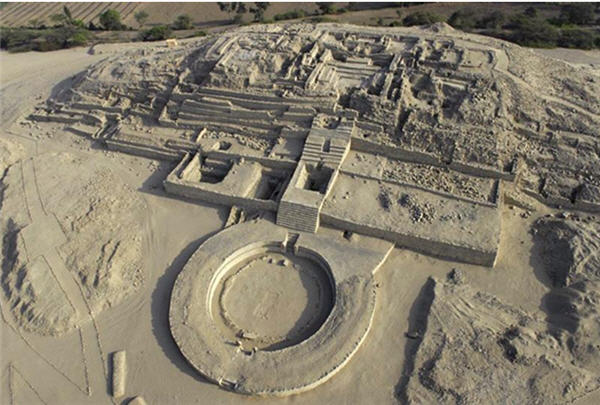As President Obama urges world leaders to tackle climate change in Paris for COP21, members from the 124 nation group of the International Union of Architects plan to present to the Paris summit the Caral Letter, a letter celebrating the ancient city of Caral-Supe in Peru as a model for sustainable living in the twenty-first century. This initiative is an example of how archaeology can be used to engage the problems our society currently faces by studying the past for ways to plan for a better future.

The city of Caral overlooking the Supe river valley.
The city of Caral-Supe was home to the Notre Chico people and can be traced back to the Late Archaic period of the Central Andes and is also the oldest center of civilization in the Americas. Caral is 5000 years old and 626 hectares, situated on a dry desert terrace overlooking the green valley of the Supe river.
Caral is famous for the ways its engineers developed the complex city using basic tools, representing inspiration to current world leaders and engineers trying to tackle climate change. The city incorporates sunken amphitheaters, pyramids, and underground ducts that once channeled winds to keep fires burning (globalpost.com). Moreover, Caral is situated in a seismically active area, and engineers of Caral innovated the use of flexible foundations called “shicras” to stabilize structures in the city.

A picture of one of the structures in the city of Caral.
The city also epitomizes a message about how our society should respect the environment. “This society was very interested in developing in harmony with nature. They never occupied the valley, they didn’t settle on productive land. Fertile fields were deities,” said Peruvian archaeologist Ruth Shady, who conducted the first excavations at Caral in 1996 and brought the site to world attention (globalpost.com). The city of Caral-Supe is an admirable example for architects to present to the climate summit not only because it serves to inspire current world leaders and engineers with the extraordinary tasks people accomplished with only basic tools, but also because the people of Caral intimately respected their environment – a pertinent message for world leaders looking to solve climate change.
The city of Caral-Supe shows that archaeology can be a means of tackling the problems our society faces today by providing examples about how we faced – and overcame – similar challenges posed in the past.
“We turn to the past to see how civilization was organized 5,000 years ago, thinking about their commitment to nature, their cosmic vision,” said Jose Arispe, one of Peru’s leading architects and an adviser with the International Union of Architects. (globalpost.com)
References
http://whc.unesco.org/en/list/1269
http://www.peruthisweek.com/news-ancient-citadel-of-caral-inspires-modern-builders-108134
Photo 1 http://media.npr.org/assets/img/2013/02/26/caral_2-6202c5022d4f3a304ac051b478a0acb728860ab7-s900-c85.jpeg
Photo 2 http://www.ancient-wisdom.com/Images/countries/American%20pics/caralpyramidmayor.jpg
Further Reading
Gigapan of Caral-Supe http://gigapan.com/gigapans/163382


